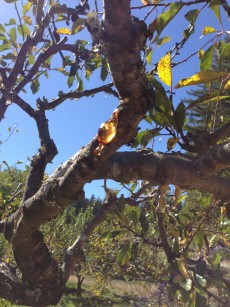
A Facebook friend recently posted a picture of gummosis on her dwarf nectarine. While pruning her fruit trees she found the sticky stuff and shared her plight. While some folks post pictures of babies and political opinions on their Facebook page, my friends post pictures of plants and their fruit trees. Yes, if you haven’t already done so, this is the time to winter prune fruit trees and apply dormant spray to fend off diseases and insect pests. With rainfall expected throughout the spring this is not the year to omit this important task.
Why prune your fruit trees in winter? The reasons to prune fruit trees are to increase fruit production, develop strong 45-degree branch angles to support fruit load, remove limbs that grow down or straight up, maintain tree size and maintain fruit spurs. The dormant season is the best time to train a fruit tree during its first three years. Pruning trees during the dormant period tends to have an invigorating effect on the tree. Good for a young tree, not so good if you are trying to control size.

Pruning of dead or diseased branches can be done anytime, however, the sooner the better. And don’t prune suckers in the winter. This insures they will grow back in the summer. Over zealous winter pruning can result in waterspouts so go easy at this time of year. Summer pruning, done in June or July, decreases size and vigor which helps to slow the growth of a tree.
Often I’m asked whether to paint a wound with sealing compound after pruning. This is no longer recommended as it encourages wood rot. A tree is best protected by proper pruning technique and timing. With this in mind, don’t prune during late spring or fall as a tree is most vulnerable during those times. When you cut away part of a plant, a would is left, susceptible to pests and diseases. To avoid trouble always prune so as to make small wounds, rather than large ones. Trimming a bud or twig produces a smaller wound than waiting until it is a large limb. Rubbing off a sucker bud leaves a smaller wound than if you want until it has a year’s growth or more.
My friends sticky amber gum oozing from her dwarf nectarine branch is the tree’s reaction to stress. Cankers or sunken lesions covered with gum may be caused by mechanical injuries, such as lawnmowers or pruning, insects, winter damage, sun scald, herbicide injury or various fungal or bacterial infections. Practice good sanitation by removing and destroying cankered limbs.
You can prevent or control many diseases and overwintering insects by applying a dormant spray this month. This can be the most effective spray of the season. Fungal diseases such as peach leaf curl, fire blight, scab and anthracnose as well as insects including aphids, San Jose scale, bud moth, leaf roller, coddling moth and whitefly larvae, mealybugs and mites can all be controlled.
There are several types of dormant sprays and all three types are considered organic. Lime-Sulfur or copper can be mixed with horticultural oil which smothers overwintering insects and eggs. This spray is good for all fruit trees except apricots which should be sprayed in the fall with copper and this month with horticultural oil.
Apply dormant spray when the temperature is above 40 degrees. Make sure you cover every nook and cranny of each branch and trunk until the tree is dripping and spray the surrounding soil. Spray only plants that have suffered from pests or disease. Sprays, even organic, can kill beneficial insects as well. Even though they’re organic, dormant sprays can be irritating to skin and eyes, Wear long sleeves and gloves and eye protection.
I hope I don’t find any pictures on Facebook of your plant pests or diseases but post away if you something wicked your way comes and I’ll try to help.
